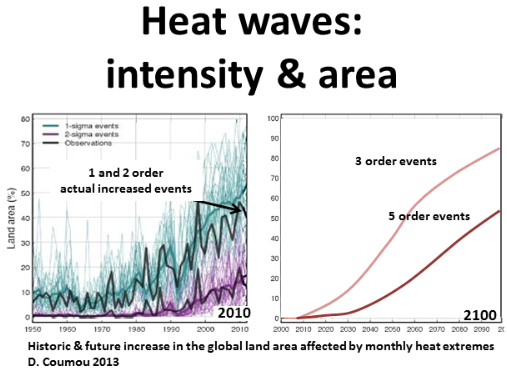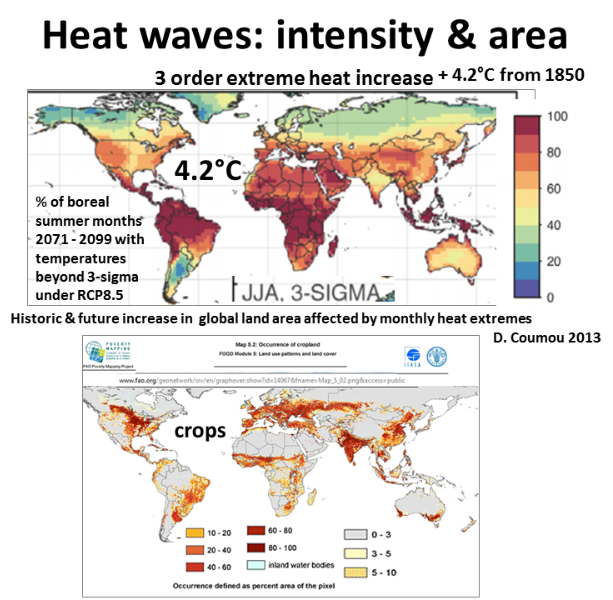Other online resources
Global warming increases heat waves, drought, wildfires, storms and floods
It was always predictable by the basic science that constant atmospheric GHG pollution, with increasing GHGs in the atmosphere, would lead to increased extreme weather. Global warming will increase extreme heat leading to increased drought, which together will increase the risk of wildfires. .
As global warming increases, climate extremes increase along with the average temperature and climate. The most obvious is heat waves with increased forest fires.
Global warming has so far significantly increased extreme heat events.
Computer models studies confirm that as global warming rises so will heat waves. By 2040 the areas affected will have increased several fold, and we are committed to this by climate system inertia.
Climatic warming of about 0.5 ° C in the global mean since the 1970s has strongly increased the occurrence-probability of heat extremes on monthly to seasonal time scales. For the near-term (i.e., by 2040), the models predict a robust, several-fold increase in the frequency of such heat extremes, irrespective of the emission scenario. Unmitigated climate change causes most (>50%) continental regions to move to a new climatic regime with the coldest summer months by the end of the century substantially hotter than the hottest experienced today.
It was always predictable by the basic science that constant atmospheric GHG pollution, with increasing GHGs in the atmosphere, would lead to increased extreme weather. Global warming will increase extreme heat leading to increased drought, which together will increase the risk of wildfires. .
As global warming increases, climate extremes increase along with the average temperature and climate. The most obvious is heat waves with increased forest fires.
Global warming has so far significantly increased extreme heat events.
Computer models studies confirm that as global warming rises so will heat waves. By 2040 the areas affected will have increased several fold, and we are committed to this by climate system inertia.
Climatic warming of about 0.5 ° C in the global mean since the 1970s has strongly increased the occurrence-probability of heat extremes on monthly to seasonal time scales. For the near-term (i.e., by 2040), the models predict a robust, several-fold increase in the frequency of such heat extremes, irrespective of the emission scenario. Unmitigated climate change causes most (>50%) continental regions to move to a new climatic regime with the coldest summer months by the end of the century substantially hotter than the hottest experienced today.
New Research
October 12, 2017 US fires worse from climate change
2 Oct 2017 360.Yale A Warmer World Is Sparking More and Bigger Wildfires
29 Aug 2017 Research in ancient forests show link between climate change and wildfires
27 July 2017 Physorg
Climate change will feed wildfires: experts
31 May 2017 Fires, storms, insects: climate change increases risks for forests worldwide
July 2015 Climate-induced variations in global wildfire
danger from 1979 to 2013
W. Jolly
30 March 2015 Chile Massive climate catastrophe: floods+fires+drought
October 12, 2017 US fires worse from climate change
2 Oct 2017 360.Yale A Warmer World Is Sparking More and Bigger Wildfires
29 Aug 2017 Research in ancient forests show link between climate change and wildfires
27 July 2017 Physorg
Climate change will feed wildfires: experts
31 May 2017 Fires, storms, insects: climate change increases risks for forests worldwide
July 2015 Climate-induced variations in global wildfire
danger from 1979 to 2013
W. Jolly
30 March 2015 Chile Massive climate catastrophe: floods+fires+drought
Wild Fires
Other online resources
Global warming IS increasing wild fires
31 May 2017 Fires, storms, insects: climate change increases risks for forests worldwide
As expected global warming causes more heat waves, and also more forest wildfires. How ever it's also the case that the biggest fires that regularly appear every year are intentionally set for slash and burn agriculture.
31 May 2017 Fires, storms, insects: climate change increases risks for forests worldwide
As expected global warming causes more heat waves, and also more forest wildfires. How ever it's also the case that the biggest fires that regularly appear every year are intentionally set for slash and burn agriculture.
Examples of extreme weather include both the drought and the flooding in Colorado in the summer of 2013. As this article by Climate Central's Andrew Freedman makes clear, 2013 was one of the drier years on record, an important factor in the huge, record-setting wildfires seen in that state over the summer. Then, one extreme suddenly shifted into the other, dropping half of Colorado's average annual rainfall in just a few days. Mr. Freedman's article does a good job of explaining the unusual weather conditions that caused the flood, as well as the relationship between this specific weather event and climate change. A ClimateProgress article by Katie Valentine brings home the severity of the Colorado floods very well.
Jeff Masters' summary of the extreme weather events across the globe in 2010 is available from Wunderground. He does a good job of putting that strange year in the context of climate change as well.
Jeff Masters' summary of the extreme weather events across the globe in 2010 is available from Wunderground. He does a good job of putting that strange year in the context of climate change as well.


VIDEO Dec 2015
The Hottest
Year on Record
-the extremes
The Hottest
Year on Record
-the extremes
2015 John Holdren VIDEO 3 min Fires


NASA FIRMS world fire map (daily)